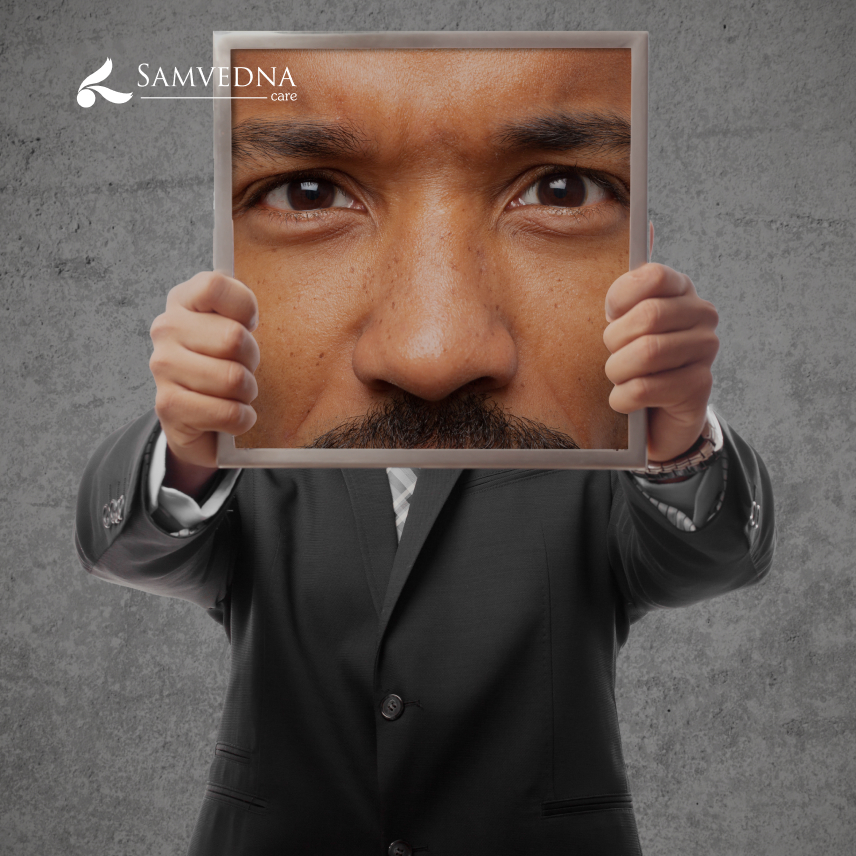Contact Us




Children are often seen as perfectly wonderful in their own way: noisy, messy, and unpredictable, yet full of charm with their gap-toothed smiles, tiny feet, and round bellies. As we grow, however, it’s easy to lose that sense of appreciation for our bodies. We often become our harshest critics. This self-criticism can sometimes become so intense that it leads to body dysmorphia.
While many of us might notice small imperfections when we look in the mirror, perhaps a detail in our face or body, it usually doesn’t severely affect our day-to-day lives. For those with body dysmorphia (or body dysmorphic disorder), though, the fixation on perceived flaws can lead to significant distress, impacting all areas of life. In today’s world, where social media often dictates beauty standards, body image struggles are becoming more common.
BDD, which affects about 1-2% of the population, is often misunderstood or dismissed. As mental health therapists at Samvedna Care, we believe it’s crucial to remember that we are all beautifully imperfect. It’s easy to fixate on what brings discomfort, but it’s equally important to focus on what brings joy and peace.
Body dysmorphia, also known as body dysmorphic disorder (BDD), is a mental health condition where an individual becomes excessively preoccupied with perceived flaws or defects in their appearance, which are either minor or nonexistent. This preoccupation can lead to severe distress, affecting self-esteem, relationships, and daily functioning. Unlike the occasional insecurity most people experience, BDD involves an intense and constant obsession with these perceived flaws, to the point where it takes over a person’s thoughts and actions.
BDD is more than dissatisfaction with appearance; it’s a debilitating condition that deeply affects mental well-being. People with BDD often experience:
Living with Body Dysmorphic Disorder (BDD) can feel like being trapped in a cycle of negative self-criticism and distress. However, recovery is possible through therapy, self-compassion, and the development of healthy coping strategies. If you or someone you know is struggling with BDD, it’s important to recognize that healing takes time, and each step forward is a step toward greater peace and self-acceptance.
Here are some effective coping strategies to help manage the symptoms of BDD and move towards a healthier relationship with your body and mind:
CBT is one of the most effective treatments for Body Dysmorphic Disorder. It helps individuals identify and challenge distorted thoughts and beliefs about their appearance. Through CBT, individuals can learn to:
With the support of a mental health therapist, CBT can provide lasting changes by shifting how you view yourself and your body.
Mindfulness practices, such as deep breathing, meditation, and body scans, can help bring attention back to the present moment. These techniques help reduce the overwhelming thoughts associated with BDD and calm the body’s stress response. They teach individuals to:
Writing down your thoughts and emotions can be a powerful tool for processing feelings and challenging negative beliefs. Journaling provides a private space where you can explore your relationship with your body and:
Social media can be a significant trigger for body dysmorphia, especially with the constant exposure to filtered images and unrealistic beauty standards. Reducing time spent on social media or curating your feed to include content that promotes diversity and body positivity can help:
Taking control of your social media consumption helps reduce the comparison trap and can create a healthier digital environment.
Exercise can be beneficial for both mental and physical health, but when struggling with BDD, it’s essential to focus on movement for the sake of overall well-being rather than for appearance. Activities like yoga, swimming, or hiking can help you positively reconnect with your body, enhancing your sense of well-being and self-worth. Consider:
By focusing on enjoyment and physical health rather than appearance, you can help shift your attention and develop a more positive relationship with your body.
Seeking therapy from a licensed mental health therapist, especially one with experience in treating body dysmorphia, is crucial for long-term recovery. A therapist can:
Therapy, particularly cognitive-behavioral therapy (CBT), is highly effective in treating BDD and helping individuals develop healthier body image perceptions.
One of the greatest barriers to seeking help for BDD is stigma. Many people fear being labeled as vain or superficial. It’s essential to recognize that BDD is a legitimate mental health condition, not a personality flaw, by regular mental health check-ins. Open conversations, education, and awareness can play a crucial role in breaking this stigma.
If you suspect that you or someone you care about may have body dysmorphia, it’s important to seek professional help. Treatment options such as cognitive-behavioral therapy (CBT) are effective in managing BDD. Additionally, a mental health therapist can work with the individual to address negative thought patterns, reduce compulsive behaviors, and improve self-esteem.
It’s essential to approach the subject with compassion and understanding. People with body dysmorphia often feel isolated and misunderstood, so providing a supportive environment can make a significant difference in their recovery journey. At Samvedna Care, we advocate for self-compassion and believe that everyone deserves to feel at peace with their body. Embracing our imperfections is part of what makes us unique and beautiful, both inside and out. If you or someone you know is struggling with BDD, remember that it’s okay to seek help and that there is always support available to guide you toward healing and self-acceptance.